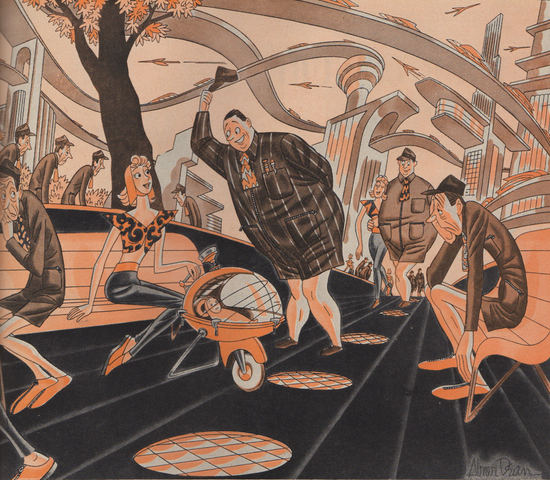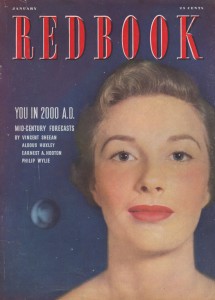Reckless Breeding of the Unfit: Earnest Hooton, Eugenics and the Human Body of the Year 2000
A future America, populated by horse-faced, spindly giants with big feet
![]()

Illustration of the human bodies of the future by Abner Dean in the January 1950 issue of Redbook magazine
In the early 1950s, many people speculated that the average American’s body would look dramatically different by the early 21st century. Some thought that the average woman of the year 2000 might be over six feet tall, incredibly athletic and just as strong as the average man. Others believed that modern conveniences like the automobile would have disastrous effects on the human body of the 21st century, creating a society of fat weaklings and scrawny depressives. You can place Earnest A. Hooton in the latter school of thought.
The January 1950 issue of Redbook magazine included the predictions of Hooton, a pioneering and often controversial anthropologist who advocated eugenics as a solution to many of America’s ills. As Hooton saw it, the progressive trends of the first half of the 20th century had only served to produce humans less fit for survival:
The human animal has undergone astonishing bodily changes during the last half century. The physical features of our population in 2000 A.D. can be predicted with grim assurance unless present trends are corrected by a science of man.
Changes in the physiques of Americans through more than fifty years are recorded in the gymnasium records of universities and colleges, in successive surveys of soldiers during two wars, of immigrants, delinquents and other elements of the population. Among the best data are those on Harvard sons and fathers and corresponding information from four Eastern women’s colleges.
Harvard sons are bigger than their fathers in twenty-seven of thirty measurements. Notably, they are more than one and one-third inches taller, more than ten pounds heavier, longer in the legs relative to trunk length, larger in breadths and girths of the torso and longer in the forearms and lower legs. Girls differ from their mothers similarly, but have much narrower hips. These bigger dimensions sound well until studies are made of individual body types from photographs as well as measurements. Then it appears that short, broad, muscular builds are decreasing, along with the stubby, strong but fat types. On the contrary, long, taper-legged, obese types of inferior structure are on the increase, and, above all, the tall, weak “stringbeans.” With increased stature, heads are getting narrower, faces longer and narrower, palates more pinched, teeth less regular, noses more razor-backed.

January 1950 cover of Redbook magazine
Hooton believed that criminals were biologically different than non-criminals, coming down firmly on the side of nature in the “nature versus nurture” debate. He also believed that things like body type were closely tied to one’s temperament. In this vein, artist Abner Dean produced an illustration (above) for the piece which showed off the humans of the future — the happy rotund man, the depressed skinny man, and the tall, slender and largely content woman of tomorrow.
Different body types are associated with distinct kinds of temperaments and well-defined physical and social aptitudes and disabilities. Broad, muscular men (usually short) tend to be aggressive, domineering, insensitive, practical and unimaginative, military and political but not intellectual and artistic leaders. Fat types are generally easy-going, kindly, “fond of the good things of life,” sociable, admirable in family relations, etc. The tall and skinny are commonly shy, nervous, repressed, emotionally unstable, intellectual and idealistic, but difficult in social relations.
The auto has made walking obsolete (witness the poorly muscled modern legs). Work requiring strenuous muscular exertion is no longer usual for growing youth and for most adults. Sports and physical education hardly compensate for the sedentary habits that have sapped the stamina of the masses in our nation.
Infant and juvenile mortality has decreased astoundingly through improved medical care and sanitation. The upsurge of the tall and skinny among adults is probably due in part to the preservation of elongate, fragile babies who now live to reproduce their kind. The proportion of the aged, too, has increased enormously, partly because of better medical care, but also because of easy living. So we have more of those too weak for work because of youth or age.
As Nicole Rafter notes in her 2004 paper on the biological tradition in American criminology, Hooton believed that financial aid to the poor was hindering the progress of the human race: “The welfare programs of the New Deal seemed to Hooton to coddle an already weak segment of the population that might better be allowed to die off; unwittingly, government policies were encouraging regressive trends in human evolution. Deeply disturbed by the apparent downward rush of civilization, Hooton predicted social, political and genetic doom.”
This description of Hooton is in line with his distaste for the “reckless breeding of the unfit” (terminology that largely fell out of fashion in academia after WWII).
There can be little doubt of the increase during the past fifty years of mental defectives, psychopaths, criminals, economic incompetents and the chronically diseased. We owe this to the intervention of charity, “welfare” and medical science, and to the reckless breeding of the unfit.
In 2000, apart from the horde of proliferating morons, the commonest type of normal male will be taller and more gangling than ever, with big feet, horse-faces and deformed dental arches. The typical women will be similar—probably less busty and buttocky than those of our generation. These spindly giants will be intelligent, not combative, full of humanitarianism, allergies and inhibitions—stewing in their own introspections. Probably they will be long-lived; the elongated shrivel and buckle, but hang on.
There will also be a strong minority of towering heavyweights—melon-shaped, with knock-kneed shanks, small hands and feet and sociable dispositions. Ultimately this type may lead, because it is philoprogenitive, if not overly prolific. The lean and hungry Cassii and Cassandras propagate briefly and parsimoniously, then separate and sulk in celibacy.
The stubby, bone-and-muscle Mr. Americas of today seem doomed to disappear or to be reduced to the ranks of institutionalized malefactors (judging from studies of present types of juvenile delinquents), instead of becoming dictators, they will be outlaws, since with attenuation of body-build the temperaments of the masses will probably change, so that idealism and intelligence will not be enslaved by brutishness.
Sex illusions will persist. Men will still think women beautiful; women will still regard men as brainy and virile; reproduction will go on. But a science of man could intervene to effect a real improvement of the human animal within the next half-century.
Hooton passed away just four years after publication of this article at the age of 66. He remained an advocate of eugenics until his death.
/https://tf-cmsv2-smithsonianmag-media.s3.amazonaws.com/accounts/headshot/matt-novak-240.jpg)
/https://tf-cmsv2-smithsonianmag-media.s3.amazonaws.com/accounts/headshot/matt-novak-240.jpg)